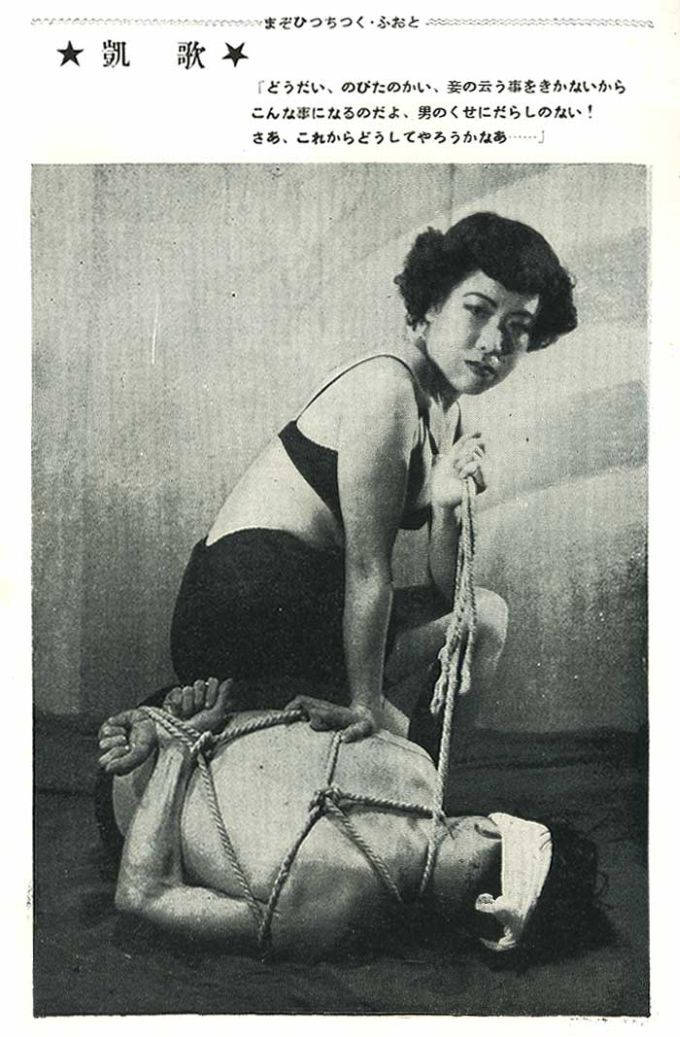A Guardian article on Nobuyoshi Araki caught my eye recently and sent me on a trip down memory lane. If you haven’t heard the name before, he’s a prolific and famous Japanese photographer. He’s probably best known for his images of Kinbaku, aka women in bondage (for example this, this and this). The article itself is a fairly silly one on on the nonsensical topic of art versus pornography, but the man himself has a special place in my heart.
I originally came across his work in the 1990’s when I was still in college. One of the major British television networks showed a documentary about him, which was surprising given the explicit nature of his artwork. The program featured a lot of bondage and showed him working with riggers and models to create complex and beautiful shots. I found it amazing. At the time my exposure to BDSM imagery, and particularly bondage imagery, was very limited. The UK had strict rules on BDSM porn and most of it was either sloppy cheap vintage bondage or cheesy commercial rubbish. Yet here was a real artist taking the subject seriously, working with a skilled team, and showing how beautiful proper rope bondage could be. It opened my eyes to the potential of BDSM for being more than just a bit of kinky fun in the bedroom.
Unfortunately, for the purposes of this blog, I’m not aware of any femdom slanted pieces that he has done. So instead I’ll feature some alternative Japanese bondage, in this case it’s a vintage piece from 1954.
You can see more from the same publication in this gallery. I believe (based on Google Translation) it’s from a magazine called Kitan Club.

“…the nonsensical topic of art versus pornography”
Interesting.
My Mistress is a self-identified feminist activist, and as part of our connection across 3500 miles of ocean, I regularly send her images with comments or captions.
We’ve had a bit of a debate about what constitues ‘pornography’, and are agreed that it’s a discussion minefield. However, as far as she’s concerned, apart from considerations regarding the conditions in which erotic art is produced, i.e. the working conditions of those employed in the ‘industry’, what separates ‘erotica’ from ‘porn’ is that the former has aesthetic merit.
Obviously that simply kicks the debate into another difficult area, but I think I can see where she’s coming from.
Interestingly, a painting like Courbet’s ‘L’Origine du Monde’ (a full-on depiction of a woman’s genitals) was originally banned as pornographic, but is now exhibited as a work of art, even though one of the references that Courbet used for the painting was a 19th century pornographic image.
As I said, it’s a moral and aesthetic minefield, but I wouldn’t say it’s nonsensical or not worth debating.
Incidentally, she hasn’t objected to anything I’ve sent her, but since the images are almost exclusively about male submission, that is possibly understandable.
I do think it’s a fascinating topic and I love debating this kind of stuff. But I still maintain the idea of splitting something into art or pornography is a nonsensical one 🙂
Partly, because nobody can agree on the definitions of pornography, erotica or even art for that matter. It seems problematic to try and categorize something in a binary fashion if nobody can agree on the category definitions.
Personally I take a simple approach to pornography. It’s explicit sexual material. As such it’s a subset of erotica for me. Any material that creates a feeling of sexual excitement is erotic, but only those that do so via explicit sexual images/descriptions/whatever are pornographic. But I realize this is personal definition not everyone shares.
However, I do think the idea that art can cease to become art and cross some line into pornography is nonsensical. Art cannot cease to be art based on what it depicts. It doesn’t make sense that Araki could shoot one image that was art and then reveal a little more of the models naked body and suddenly cease to be creating art. Non-art can be turned into art (Duchamp’s urinal springs to mind), but I don’t think the subject matter has the power to negate the creative process.
The Courbet piece is a good example. I think it makes sense to maintain it was always art and never pornographic (if you hold the view like the US Supreme Court that pornography has no redeeming social value, so therefore art cannot be pornography). I also think it makes sense to say it’s both pornographic and art. Or even that it was once pornographic and art, but is now just art, as societies standards have changed. But it doesn’t make sense to me that the subject itself could make it cease to be art.
-paltego
“It seems problematic to try and categorize something in a binary fashion if nobody can agree on the category definitions.”
True. I’m a great fan of probabilistic reasoning and fuzzy logic in the appropriate context, so you’re preaching to the converted.
Maybe we could agree that ‘pornographic’ is a scaling adjective, like ‘tall’, or ‘hot’.
“(Duchamp’s urinal springs to mind)”
Also Duchamp’s ‘Etant donnés…’ which is clearly influenced by Courbet.
Great blog btw.
At first I was going to say that for me pornographic is more of a subject matter description than a scale. But you’re right, it can also be a scale. The concept of something being particularly pornographic or just mildly so does make some sort of sense. However, I do think it’s scale that’s entirely orthogonal from the question of art.
And thanks, glad you like the blog.
-paltego